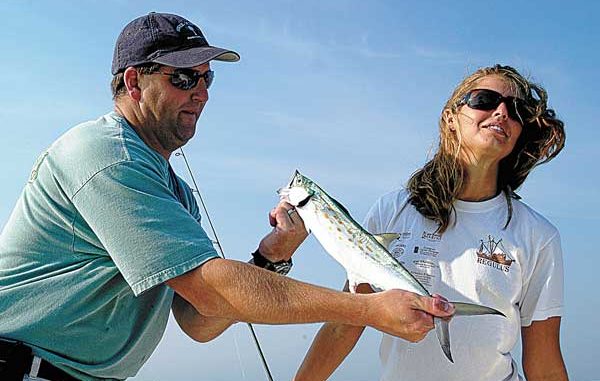
Fall brings a feeding frenzy for king and Spanish mackerel at N.C. Coast.
Even after sleeping an extra hour and leaving the dock at 8 a.m. rather than 7, the morning air still had a cool nip, one of the first signs of fall’s arrival.
That’s not a bad omen for fishing, because cooler weather triggers a feeding response in many species of saltwater fish and brings on the best action of the year to the forefront in the fall.
The anglers who filled the cockpit of the Miss Ann also were full of anticipation as Capt. Michael Wells welcomed them for a beautiful fall morning last year.
Co-owners Tom Baldwin and Bruce Andrews also were aboard, along with Baldwin’s friend, Lorne Johnson, and his daughter Shannon. For a trip that had been planned weeks in advance, the weather couldn’t have been prettier. The sun arose into a near-cloudless sky as it cleared Cape Lookout and illuminated an ocean in the state old-time downeasters refer to as “flat ca’m.”
As the morning wore on, a slight breeze finally developed, barely enough to ripple the ocean and help hide the fishing lines. As the beautiful morning warmed, so did the fishing.
The plan had been to catch enough Spanish mackerel to take home several meals and have a couple dozen left to brine for marlin baits for the next billfish season.
Wells planned to begin trolling for Spanish between Beaufort Inlet and Oceana Pier, and then move to Cape Lookout. If there was time, he’d also try for some of fall kings.
But he never left the Fort Macon area. Spanish macks were plentiful and once he discovered the depth at which they were feeding, it became a matter of reeling them in and resetting lines.
While he started with four lines out, he spent much of the morning trolling only two.
Such fishing might sound easy, and truthfully, the party could have stayed a little longer and filled a 90-fish limit. The fish were plentiful and appeared to be feeding ravenously to build muscle and fat for their Florida fall migration.
After several hours of occasionally helping Shannon Johnson reel in fish, Wells counted 60 Spanish, so he decided to ease offshore and see if he could find some hungry kings. It was only 11:30 a.m.
Wells began fishing with a 4-line spread, using two No. 0 and another two No. 1 silver Clark Spoons. Off one gunwale, he trolled the lures behind a No. 2 planer and a 4-ounce trolling sinker; on the other side he used a No. 1 planer and 2-ounce trolling sinker. All leaders were clear, 20-pound test monofilament and 20 to 25 feet long.
“I wanted to put out a varied spread to see if the fish were holding at a specific depth,” Wells said. “We’re seeing them jump, but that doesn’t mean they are actively feeding near the surface. Sometimes they zone in on a specific depth or distance behind the noise of the motors, and if you don’t have a lure there, you won’t get a strike.
“By using the different means to get the spoons to different depths and positioning them at different distances behind the boat, we can see if (the fish) are feeding at random or are picky today.”
Minutes after setting the spread, the first Spanish struck, whacking the lure behind the No. 1 planer.
Shannon Johnson bounded into the fighting chair as Baldwin passed her the rod. In a few minutes, the planer clicked against the rod tip, and Baldwin hand-lined the rest of the leader in and flipped the struggling mackerel across the transom and into the waiting cooler.
Just as the lines were reset, another fish struck, but this time it was on the lure behind the heavier trolling sinker. Putting young Johnson back to work, another wiggling Spanish found its way to the Miss Ann and into the cooler.
Suddenly, Wells called down from the bridge that a school of Spanish had risen to the surface, and he was headed to them. As he passed the school, fish cut through the water, jumping and chasing bait across an area roughly half the size of a football field.
Wells was careful not to get too close, turning a wide circle as the boat passed the feeding fish.
The boat positioning was excellent. Just after passing the school, he had strikes on three of four lines. As he worked in the cockpit to get the fish in and the lines back out, Wells swung the Miss Ann to make another pass at the feeding Spanish.
He later said if the boat got too close to the fish, they’d stop feeding and dive to get away. The trick was to stay as close as possible, then turn as he passed the school to drag the lures through the baitfish the Spanish were slashing.
Subsequent passes usually brought at least double hookups. After having to clear a few line tangles, he cut back to a pair of lines. While deciding which lines to leave out, he agreed he’d been getting the majority of strikes on the lures behind the No. 1 planer. He switched the larger planer to a No. 1 and pared down to two outfits.
Many times, Spanish are size-specific regarding lures they’ll hit, but that wasn’t the case this day. He didn’t have anything really small or large, but they were aggressively attacking the Size 0 and 1 Clark Spoons.
The men reeled in fish when there were multiple hookups, so Shannon Johnson was staying busy. Her smile was just as large after several hours of reeling, but her reeling speed had slowed noticeably. She wouldn’t admit it, but she reappeared when Wells announced there were plenty of Spanish in the cooler and kings were next on the menu.
Wells said he had been listening to radio chatter for several hours and had heard a fair king bite was underway a little east of the sea buoy.
The course Wells chose was taking us to a small group of boats about a mile east of the Beaufort Inlet sea buoy. When he slowed the boat, Wells barely got the third cigar minnow in the water before the first king struck, and the reel on the far gunwale began howling everyone’s favorite song — freezing the crew.
As Andrews finally moved to pull the bent rod from its holder, the reel on the outfit right next to him sputtered a couple of times and joined in harmony. When things are going your way, it’s wise to accept they just are and life is good.
Andrews passed the first outfit to Lorne Johnson and was blocked from getting to the second, so Baldwin became the second angler by default. Baldwin’s king came to the boat first and became Gulliver to all the Lilliputian Spanish in the cooler.
As Andrews cleared the gaff and turned to get Johnson’s king, the rod tip made that little quick flip every fisherman hates and the line went limp as the small treble trailing hook pulled free.
“Sorry about that, Lorne,” Wells said. “This looks like a good bite; you should get another shot. Let’s get some more baits in the water and see who else is hungry.”
The next flurry didn’t happen quite as quickly. After four lines were dispatched and trolled about 10 minutes, another king came calling.
Shannon Johnson was still recovering from reeling in all the Spanish, so her father got his second chance, and this time, everything held. In just a few minutes, another king joined the first in the cooler.
Wells used rigs with 1/4- and 3/8-ounce Sea Striker Live Bait King Heads for the forward hook and No. 4 treble hooks as trailers. Some had single-strand wire and some with multi-strand wire.
Wells said the weighted heads were designed to help keep the dead baits upright and prevent them from spinning. He also said when rigged correctly, the dead baits could be trolled a little faster than live baits, which allows covering a little more water anglers who use live bait.
“Most folks primarily think of live bait when fishing for kings, and it may be a little better when they aren’t really active and feeding,” Wells said. “However, once they begin feeding, they aren’t real particular and trolling the dead baits a little faster allows us to cover more water and potentially put baits in front of more fish. It usually works really well with teenagers like we’re catching today.”
No question dead baits were king magnets this day; it was difficult to imagine more productive baits. When Wells spotted bait pods with his fish-finder and steered the Miss Ann to troll across them, the kings eagerly hit his baits.
After catching a few more kings, Wells headed toward shore, with lightly glowing fall sunburns and a cooler of mackerels.

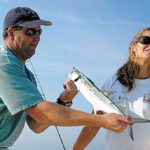
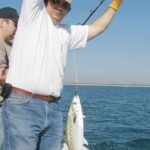
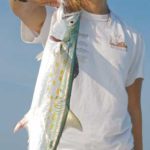
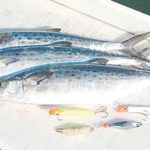
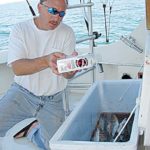
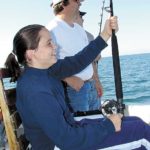
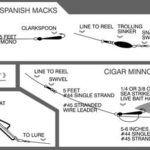
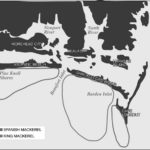



Be the first to comment